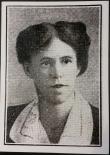Mary Wilkinson was educated privately and moved with her sister, Irene, to Melbourne, Victoria. In 1907, she entered a long poem in the Women's Work Exhibition in Melbourne, winning first prize in the poetry division. Wilkinson was active in many of the literary, cultural and feminist groups around Melbourne and committed to the development and support of Australian writing and writers. She lectured for the Australian Literary Society and wrote articles for its journal, Corroboree, and for another literary journal, Birth. Wilkinson ran a literature group with the Theosophical Society during the 1920's, lecturing on the commonality of thought in theosophy and various writers. In 1924 she published The Turning Wheel: Simple Explanation of Theosophical Terms. In 1936 she married a fellow theosophist, Arthur Osborne who was some twenty years younger than her.
Wilkinson was secretary of the play-reading group of the Melbourne Repertory Theatre Society from 1913. Some of her poetry and essays were published in small literary journals. Only one of the six plays she wrote, The Lighthouse Keeper's Wife, has been located. Wilkinson was very interested in questions of religious belief and the control that adherence to socially acceptable rules and behaviour exerted over people. This is reflected in the surviving play. She seems to have stopped writing or having her work published in the 1930s.
Her papers were lodged with the National Library of Australia after her death by her husband. Unfortunately, the vast majority of them were lost after arriving at the Library. Only remnants of her unpublished works, correspondence and other personal paper remain.
(Adapted from Kerry Kilner 'Introduction : Repertory Theatre in Australia', Playing the Past: Three Plays by Australian Women (1995): v-xvii).
 4785750127701123984.jpg
4785750127701123984.jpg